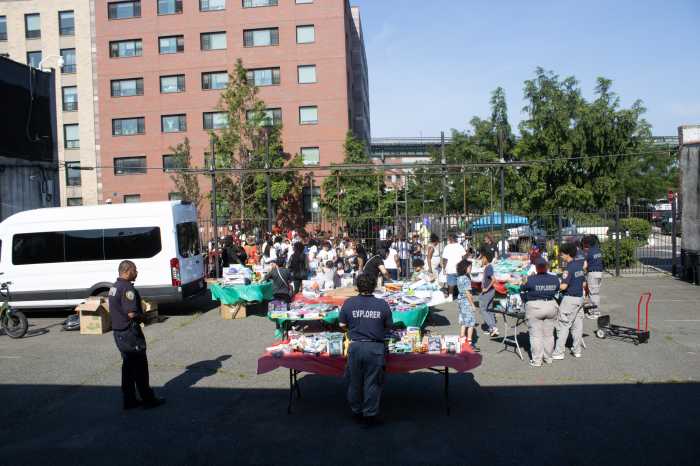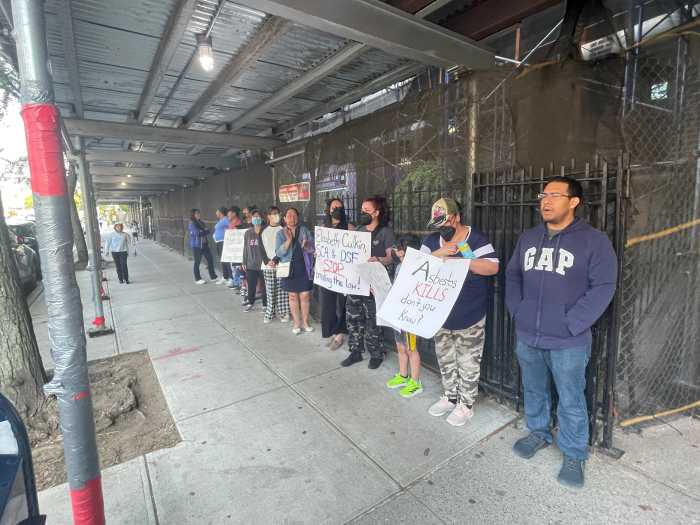BY DENNIS LYNCH | One of the East Village’s most demonized landlords, Raphael Toledano, reportedly wants to unload 13 of his buildings in the neighborhood for a sky-high $160 million. A little more than a year ago, however, he told The Villager, “I am determined to become a part of the fabric of the neighborhood.”
The Real Deal reported on Dec. 1 that Toledano is looking to sell the buildings.
However, back in June, The Villager’s Scoopy’s Notebook was, in fact, the first to get the scoop. Back then, a local real estate source tipped off the newspaper that word on the street was Toledano planned to sell his East Village real estate portfolio. As it turns out, he apparently is set to sell — but only about half of his East Village properties.

Some of Toledano’s tenants will breathe a sigh of relief after enduring the strong-arm tactics he’s allegedly used to try to force folks out of their rent-regulated apartments. Living conditions in some of his buildings were so bad that tenants formed the Toledano Tenants Coalition to face him with a united front.
Toledano settled for $1 million with tenants at one of his E. 13th St. buildings earlier this year after they sued him for allegedly harassing them. City health inspectors found lead dust in at least four of his buildings far exceeded the federal standards.
In the past couple of weeks, he again made the pages of The Villager for failing to provide cooking gas to tenants at E. 12th St. buildings for the last six months. Toledano blamed the city for slowing down repairs with inspections — but then he temporarily slashed the rent, gave out stovetop burners and signed a legal agreement to get the gas back on by the end of January.
Craig Smith and his family hope the young real estate mogul’s departure could mean an end to Smith’s ongoing litigation against Toledano. Smith charged that Toledano was illegally trying to evict them from their apartment at 233 E. Fifth St., one of the properties Toledano is shopping around. He sued after Toledano decided not to renew their lease, which is illegal if the apartment is rent-regulated, as Smith claims.
Smith’s lawsuit is legally against the limited liability company that owns 233 E. Fifth St., so if Toledano’s successor continues the eviction, Smith could continue to sue. Smith said he’s unsure how it could play out.
“There’s no way of knowing,” he said. “It could easily be worse or a better situation, we just don’t know. We’re neutral and we’ll see what happens. It’s living in a certain type of limbo.”
Smith’s particular case boils down to whether or not the apartment became deregulated when he first rented it in 2003 and his previous landlord only increased the rent so much as allowed by rent-regulation laws. It definitely was legally rent-regulated before he moved in. But when Smith moved in, the monthly rent was above the $2,000 threshold at which point an apartment can legally be deregulated. However, the previous tenant never exceeded that threshold, which suggests the apartment must remain regulated until a tenant pays above the threshold and then moves out.
It’s a common dispute and it’s only become more complicated as of last year when the rent-regulation rules were slightly modified. Previously, the only way for landlords legally to deregulate apartments that were close to the threshold was to spend a variable amount of money (based on a formula) on renovations that would justify a rent hike above the tipping point. But that changed last year, according to veteran tenant advocate Michael McKee.
“If a tenant moves out,” McKee explained, “and the rent is anything below $2,700 a month — the new threshold for rent-regulated apartments — the landlord is required to re-rent it as rent-stabilized to the new tenant. And even if the landlord spends the money to get it up to the threshold, he would still have to rent it as rent-stabilized, and only when that tenant moved out would he be able to deregulate.”
Smith won the initial case in housing court in April. But Toledano appealed and they went back to appellate court in November. The parties are waiting for an unrelated lawsuit that could have bearing on their case to proceed before pushing on any further.

Toledano bought 28 buildings in the East Village last year for $140 million through his Brookhill Properties company. Only $76 million went toward the 13 buildings he’s looking to sell, so a sale at his asking price would net him more than $80 million. But experts have said Toledano borrowed money at a high interest rate — that he’s “overleveraged” — so a chunk of that could go back toward paying off those debts.
The lender likely gave Toledano the money with a “loan to own” mindset. In other words, if the borrower can’t pay back the money, then the lender just moves in and takes the property, an expert said.
“If Toledano succeeds,” in flipping the properties, “they got a high rate of return, much higher than the prevailing rate. And if he loses, then they take the real estate. It’s a potential win in either direction,” said a source familiar with real estate in the area who requested anonymity.
Toldedano’s Brookhill Properties did not comment on the sale. But Toledano himself penned a response to allegations of his misconduct in The Villager in October 2015. In a talking point entitled, “The East Village is home; I want to improve it,” Toledano said he was in the community “for the right reasons” and that negative articles “do not paint an accurate picture of the effort” he made to improve conditions in his buildings.
On Tues., Dec. 6, Toledano tenants and activists also called out the landlord’s lenders, Madison Realty Capital and Signature Bank, for their involvement in financing his ill-fated East Village real estate spree. Dozens of area tenants and state Senator Brad Hoylman joined the Toledano Tenants Coalition, activist groups and local politicians in two protests on the Upper East Side outside the lenders’ headquarters. Accompanying them on their march between the two H.Q.’s was the Rude Mechanical Orchestra.
“New York City’s affordable housing market has become increasingly diminished in recent years,” a press release for the protest said, “and many tenants have been victims of harassment by predatory equity landlords trying to force tenants out of their homes. Banks and non-bank lenders need to maintain scrupulous standards in all their lending. Without such standards, they aid and abet bad-acting landlords who make every effort to reap huge profits through decimating the city’s stock of affordable rent-stabilized housing.”



































